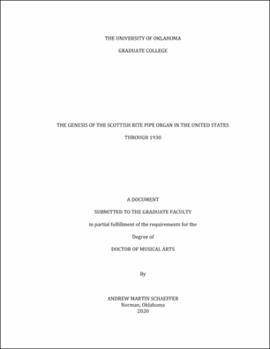| dc.description.abstract | At the dawn of the twentieth century, the pipe organ played a coveted role in the civic life of the United States. In the absence of public address systems, pipe organs, with their immense power and tonal capabilities, were logical and cost-effective ways to provide music for the masses. Thus, pipe organs were installed not only in churches, but also in stadiums, municipal auditoriums, convention halls, movie theaters, and Masonic buildings.
Hundreds if not thousands of pipe organs were built for Masonic edifices from approximately 1860 through World War II, including nearly fifty instruments for Scottish Rite Temples. The Scottish Rite is one of the appendant bodies of Freemasonry that a Master Mason may join for further exposure to the principles of Freemasonry. Initially, the Scottish Rite conferred degrees similar to the practices of other nineteenth century secret societies. However, around the turn of the twentieth century, the Rite radically revised its ritual, transitioning it from a traditional lodge experience to a theatrical one. This resulted in a membership boom and warranted the construction of lavish, regional buildings throughout the country. Furthermore, in lieu of regular weekly meetings, the practice of Scottish Rite Masonry shifted to large, biannual “reunions” which are grand spectacles of theatre and ceremony.
During the first three decades of the twentieth century, thousands of pipe organs were produced in the United States, with large companies such as M.P. Möller shipping out one pipe organ per day at the peak of production. These instruments fell into two categories: “classical” organs appropriate for church and academic settings and “theatre” organs built primarily for entertainment and characterized by the addition of tuned and untuned percussions and special effects. Yet, the ritual work of the Scottish Rite required an entirely different kind of organ. While much of the degree work is solemn, these instruments were also required to play lively marches and to accompany the hearty singing of hundreds if not thousands of men. Although some Scottish Rite pipe organs were built strictly along classical lines, others are a curious blend of classical and theatrical elements reflecting the duality of their purpose. After providing a brief history of Freemasonry, this document will survey the origins of Scottish Rite pipe organs and examine the ritualistic demands the instruments were required to meet. Finally, this document will include an examination of the pipe organ market that emerged in the late nineteenth and early twentieth centuries in order to satisfy the needs of Scottish Rite valleys. | en_US |

